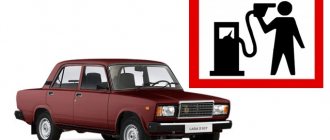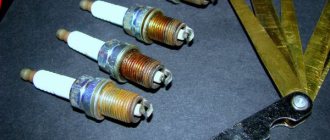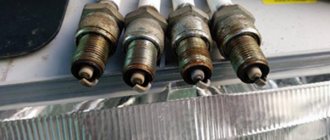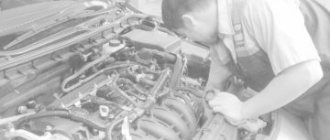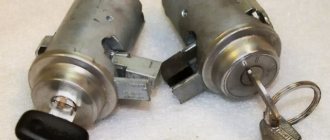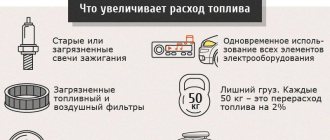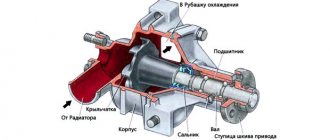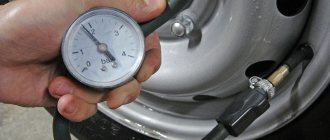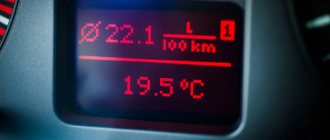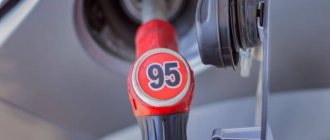What is the fuel consumption of the Niva (VAZ 2121 and VAZ 2131)
Before buying a car, you should understand what costs will be required to maintain it.
Therefore, the manufacturer in the technical specifications indicates fuel consumption data in liters per 100 km. Let's find out what numbers are indicated in the Niva 4x4 documentation and what values are found in practice during the operation of an SUV. On the official website AvtoVAZ indicates the following fuel consumption per 100 km for the Niva:
- Urban cycle - 12.1 l/100km
- Extra-urban cycle - 8.3 l/100km
- Mixed cycle - 10 l/100km
These values are the same for all Niva 4x4 injectors (3-door, 5-door and “Urban”).
Currently, the Niva plant does not produce a carburetor engine, so the figures were found in the operation, maintenance and repair manual for the Niva VAZ 21213 for 2005. There is a detailed table with fuel consumption for this SUV:
| Options | VAZ-2129 | VAZ-2129-01 | VAZ-2130 | VAZ-2131 | VAZ-21312 | VAZ-2131-01 | VAZ-21312-01 |
| Engine | VAZ-21213 | VAZ-21213 | VAZ-21213 | VAZ-21213 | VAZ-2130 | VAZ-21213 | VAZ-2130 |
| at a speed of 90 km/h | 10,3 | 10,3 | 10,3 | 9,1 | 9,3 | 9,1 | 9,3 |
| at a speed of 120 km/h | 11,8 | 11,8 | 11,8 | 12,1 | 12,3 | 12,1 | 12,3 |
| during urban driving cycle | 12,3 | 12,3 | 12,3 | 11,1 | 11,9 | 11,1 | 11,9 |
We also provide data on fuel consumption for different types of engines from Wikipedia:
- VAZ-21213 (carburetor): 8.3-11.5 l/100 km
- VAZ-2121 (carburetor): 10.8-13.4 l/100 km
- VAZ-21214 (injector): 8-9.1 l/100 km
Thus, fuel consumption on a Niva 4x4 (injector) is slightly less than with a carburetor. It is worth noting that reviews from owners of this SUV indicate that in practice the numbers may be higher. It is not uncommon to see fuel consumption of 14 l/100 km or even 15 l/100 km on a Lada 4x4.
How to reduce fuel consumption:
- Change your driving style, make acceleration smoother, and do not exceed speeds above 80..90 km/h.
- Drive more often on flat roads. On off-road, fuel consumption is significantly higher.
- Use additional electrical equipment of the car less often. For example, air conditioning, heated seats, etc.
- There may be problems with the engine. Perform diagnostics and troubleshoot problems.
- Fuel consumption on AI95 is less than on AI92.
It is worth remembering that high or increased fuel consumption is observed in winter, when the engine warms up for some time before driving.
What is the average fuel consumption on your Niva 4x4 SUV? Do you have any tips to help reduce these numbers? Let us remind you that fuel consumption also depends on the type of gasoline, so the majority of owners recommend using AI95.
If you find an error, please select a piece of text and press Ctrl+Enter.
Option 3 of 4: Driver Habits
1. Use cruise control driving technique. This often helps save fuel while maintaining a constant speed.
Also interesting: Chevrolet Niva engines: characteristics and capabilities
2. Don't rush. As the speed increases, the resistance of the oncoming air flow also increases. When driving at higher speeds, fuel consumption increases by up to 30%. At a speed not exceeding 60 km/h, the effect of air resistance on fuel consumption is practically non-existent, and at higher speeds it becomes more significant.
3. Sharp accelerations are very harmful. Internal combustion engines have an optimal operating mode at 2000-3000 rpm, and the greatest power develops at 5000-6000 rpm. When the engine reaches the required speed, you need to switch to the next gear using a manual gearbox.
For example, to accelerate a car to 50 km/h, you turn on the first, accelerate on the second, and then, skipping the third, turn on the fourth or fifth, provided the engine maintains speed. But you need to remember that when you press the gas pedal in fifth gear at low speed, there will be no acceleration. In this case, you can switch to a lower gear .
4. Try to brake as little as possible, because for subsequent acceleration you will use up fuel that could be saved. Carefully monitor the operation of traffic lights to avoid unnecessary acceleration.
5. You should not warm up the car while idling. It is better to do this by starting slowly, avoiding jerky accelerations until the engine reaches the required temperature.
6. Decide on the optimal speed in relation to the amount of fuel consumed. Often this is 80 km/h. Optimal speed involves minimum speed in maximum gear. For example, the optimal speed of Jeep Cherokees is 90 km/h, and Toyota 4Runners is 80 km/h . Determine the optimal speed of your car, try to stick to this speed when traveling.
7. Some cars are equipped with gearboxes that have an “overdrive” function. If your car is one of those equipped with this device, turn it on in a timely manner. In some cases, turning it on is inappropriate, for example, when towing a large load. The “overdrive” function is considered to be turned on by default when the gearbox lever is in the “D” position. In some cars, this function is turned off with a button. But it can turn off when the engine brakes while moving down, or, conversely, when going up. This feature contributes to slight fuel savings by allowing you to maintain speed at low engine speeds.
8. Carefully monitor the operation of traffic lights . Sharp acceleration and braking do not have the best effect on the Niva’s consumption. You shouldn’t circle around the parking lot for a long time, burning fuel, to choose a more convenient place. You have to accept that the most convenient seats are always occupied.
9. Maintaining a safe distance is very important. Driving at a short distance forces you to brake and accelerate much more often than driving 20 meters at the same speed. You will gain time for braking at traffic lights, you will have to brake significantly less in connection with the car in front, and you will also have the opportunity to maneuver.
10. Long-term heating has an adverse effect on Niva consumption. In the cold season, 30 seconds is enough . During this time, the engine is already sufficiently lubricated for safe operation. If you stop for more than 10 seconds, turn it off. This will also help save fuel. But keep in mind that if you start the engine frequently, you will damage the starter.
11. Decide on the gear that is most suitable for uniform movement. When driving lightly on the highway, you can resort to the highest gear. Listen carefully to the operation of the engine, since driving in a high gear is fraught with malfunctions in insufficiently powerful engines. Some manufacturers offer various versions of the gear ratio in the gearbox.
Also interesting: Relay and fuse diagram for Lada Niva (Chevrolet) » Lada.Online
What is the fuel consumption of Lada 4×4 (VAZ 2121 and VAZ 2131)
Before buying a car, you should understand what costs will be required to maintain it. Therefore, the manufacturer in the technical specifications indicates fuel consumption data in liters per 100 km. Let's find out what numbers are indicated in the Lada 4x4 documentation and what values are found in practice during the operation of an SUV.
On the official website AvtoVAZ indicates the following fuel consumption per 100 km for Lada 4×4:
- Urban cycle - 12.1 l/100km
- Extra-urban cycle – 8.3 l/100km
- Mixed cycle – 10 l/100km
These values are the same for all Lada 4x4 injectors (3-door, 5-door and “Urban”).
The manufacturer notes that fuel consumption data was determined under standardized conditions using special measuring equipment, in accordance with the requirements of GOST R41.101–99 (UNECE Rules No. 101). Used to compare cars from different automakers. They are not an operational standard.
Currently, the plant does not produce Lada with a carburetor engine, so the figures were found in the operating, maintenance and repair manual for the Lada 4×4 car for 2005. There is a detailed table with fuel consumption for this SUV:
| Options | VAZ-2129 | VAZ-2129-01 | VAZ-2130 | VAZ-2131 | VAZ-21312 | VAZ-2131-01 | VAZ-21312-01 |
| Engine | VAZ-21213 | VAZ-21213 | VAZ-21213 | VAZ-21213 | VAZ-2130 | VAZ-21213 | VAZ-2130 |
| Gasoline consumption per 100 km when driving in top gear, no more than, l | |||||||
| at a speed of 90 km/h | 10,3 | 10,3 | 10,3 | 9,1 | 9,3 | 9,1 | 9,3 |
| at a speed of 120 km/h | 11,8 | 11,8 | 11,8 | 12,1 | 12,3 | 12,1 | 12,3 |
| during urban driving cycle | 12,3 | 12,3 | 12,3 | 11,1 | 11,9 | 11,1 | 11,9 |
We also provide data on fuel consumption for different types of engines from Wikipedia:
- VAZ-2121 (carburetor): 10.8-13.4 l/100 km
- VAZ-21213 (carburetor): 8.3-11.5 l/100 km
- VAZ-21214 (injector): 8-9.1 l/100 km
Thus, fuel consumption on a Lada 4x4 (injector) is slightly less than with a carburetor. It is worth noting that reviews from owners of this SUV indicate that in practice the numbers may be higher. It is not uncommon to see fuel consumption of 14 l/100 km or even 15 l/100 km on a Lada 4x4.
How to reduce fuel consumption:
- Change your driving style, make acceleration smoother, and do not exceed speeds above 80..90 km/h.
- Drive more often on flat roads. On off-road, fuel consumption is significantly higher.
- Use additional electrical equipment of the car less often. For example, air conditioning, heated seats, etc.
- There may be problems with the engine. Perform diagnostics and troubleshoot problems.
- Fuel consumption on AI95 is less than on AI92.
It is worth remembering that high or increased fuel consumption is observed in winter, when the engine warms up for some time before driving.
What is the average fuel consumption on your Lada 4x4 SUV? Do you have any tips to help reduce these numbers? Let us remind you that fuel consumption also depends on the type of gasoline, so the majority of owners recommend using AI95.
Ways to save fuel
Rising prices for all types of fuel always upset drivers. And although the forecasts for the future are very disappointing, we will tell you how to save up to 20% of fuel using the following simple techniques. 1. Shift Early Forget what you were taught in driving school: that internal combustion engines consume less fuel in the mid-range engine speed range. For modern engines this rule is no longer relevant. New engines with fuel injection systems operate most efficiently at lower speeds. For example, today's diesel engines produce maximum torque around 1700-1800 rpm. 2. Fifty in Fifth When you accelerate at full throttle (but not in kick-down mode), the choke is wide open and the engine is running at its most efficient. Without bringing the tachometer needle to 2000 rpm, you need to switch to a higher gear. Anyone who starts with the gas pedal lightly pressed is throwing money away. At the same time, select the highest gear your engine allows. There's no shame in driving at 50 km/h in fifth gear.
3. Release the accelerator, but do not switch to neutral. Use engine braking instead of coasting and normal braking. Injection engines immediately stop supplying “extra” fuel as soon as the gas pedal is released. This technique is especially applicable when you see a red traffic light from afar. Those who approach traffic lights in neutral actually use more gas.
4. No “stop-and-go” Be prudent and consistent while driving. To save fuel, maintain more than just a safe distance. This will allow you to brake less often than the car ahead. Therefore, you will not lose the energy of inertia, to obtain which you spent a certain portion of fuel. Although this technique will take a little time, it will greatly save fuel and nerves. 5. Avoid maximum speeds Do not travel at high speeds. The effect of this is known: with a slight increase in speed, fuel consumption is much greater due to the significantly increased aerodynamic drag.
6. Turn off additional “fuel eaters” Do not use the heated rear window, power windows, all types of interior lighting, heated seats, air conditioning and other consumers of electricity unless necessary. For example, an air conditioner can “eat” 1.5 liters of fuel for every 100 kilometers. Forgotten and not turned off rear window heating - about 0.4 liters.
7. Down with all the ballast. If left on the roof, the roof rack will cost you money after your holiday trip. At a speed of 80 km/h, it “consumes” about 0.7 liters, and a bicycle attached to it even more, up to 3 l/100 km. Every extra 100 kilograms in the trunk or interior will lighten your pocket by the cost of 0.6 liters of gasoline for every 100 kilometers in the urban driving cycle.
8. Pay attention to the correct tire pressure. If your tires are too underinflated, this increases rolling resistance. With increased air pressure there is less resistance, however, it increases the stiffness of the suspension and worsens comfort. You can find the “correct” pressure in the technical documentation for your car, or on special stickers, which are usually placed on the driver’s side B-pillar or on the gas filler flap. Before long trips with additional load, increase the pressure according to the instructions. With optimal tire pressure, you can save up to 5% on fuel.
Direct link https://autoclub.perm.ru/index.php?showtopic=260
What is the fuel consumption of the Chevrolet Niva per 100 km and how to reduce it?
The 1.8-liter Opel engine has the best performance. With a power of 125 horsepower per 100 kilometers, it consumes:
- 12.7 liters in the city;
- 8.4 liters on the highway;
- 10.3 liters in the combined cycle.
Engines with a volume of 1.7 liters produced by AvtoVAZ are distinguished by higher consumption and lower power. The 82-horsepower Euro-5 engine consumes:
- 14.1 liters in the city;
- 8.8 liters on the highway;
- 11.2 liters in the combined cycle.
The outdated 1.7 liter engine model without auxiliary devices, which meets the Euro-2 environmental standard, consumes slightly less - 10.8 l/100 km in the combined cycle.
Oddly enough, you have to pay for environmental friendliness with high fuel consumption. But AvtoVAZ no longer supplies Opel engines, which at the same time save the owner’s wallet.
Reduced consumption
Many Chevrolet Niva car owners are not satisfied with the actual consumption, since it is quite different from what is stated in the passport; especially for this purpose, below we present the most popular methods to reduce it.
- The smoothness of the car, you can notice that modern cars have become streamlined, which reduces consumption, this can be achieved by tuning the car yourself, but, for example, if you put roof rails on the roof of the car, then due to the fact that the aerodynamics will worsen, the fuel consumption will increase .
- You should pay attention to the wheels, if the pressure in them is less than normal, then consumption increases, since the resistance with the road surface decreases, so it is better if the pressure is the required one or a little more, for example, 0.35 bar.
- Electrical appliances can also cause high fuel consumption, since they are powered by a generator that uses engine resources, so to make driving more economical, electrical appliances should be turned on when necessary, thereby reducing fuel consumption in the tank.
- To reduce fuel consumption, the air filter should be maintained. In addition, check the oil in a timely manner.
- Consumption is also affected by the gasoline itself and the additives you use.
It should also be added to the entire list that you need to keep an eye on the gas pedal, since depending on what driving style you have and your consumption, if it is aggressive and the gas pedal is constantly pressed all the way, then the consumption will increase accordingly.
Also pay attention to the transmission, as it can also affect how often you fill up your car.
Therefore, if you do not resort to advice, but use what is given above, the result will not take long to arrive, since the power will remain at the same level, and the consumption will be less.
The 1.8-liter Opel engine has the best performance. With a power of 125 horsepower per 100 kilometers, it consumes:
- 12.7 liters in the city;
- 8.4 liters on the highway;
- 10.3 liters in the combined cycle.
Engines with a volume of 1.7 liters produced by AvtoVAZ are distinguished by higher consumption and lower power. The 82-horsepower Euro-5 engine consumes:
- 14.1 liters in the city;
- 8.8 liters on the highway;
- 11.2 liters in the combined cycle.
Why does Chevy Niva consume more fuel?
The technical characteristics declared by the manufacturer do not quite correspond to the real ones.
This applies not only to the Chevrolet Niva, but to any car. The engine efficiency indicated in the official documentation is achievable only with a fully functional car on a good road with a calm driving style.
In this case, high-quality gasoline should be used and there should even be no headwind. Therefore, actual consumption is always higher than stated.
Even with ideal technical condition, the turned on air conditioner and aggressive driving style can add from 1 to 3-4 liters per 100 kilometers.
In winter, fuel consumption increases by 10-20% depending on the mileage. If you warm up the car for 10 minutes before driving a couple of kilometers, consumption can increase to 20 liters.
The following factors also affect the efficiency of the machine:
- Condition of the road surface. On broken asphalt, country roads, mud, snow or sand, the car needs more fuel.
- Condition of the engine, ignition and fuel system. Weak compression, clogged injector and other problems worsen engine efficiency.
- Incorrect wheel alignment angles, insufficient tire pressure. These factors increase rolling resistance, resulting in more fuel consumption.
Important: You can talk about excessive consumption if the car, with a calm driving style and with the air conditioning turned off, consumes at least 15% more fuel than normal. In this case, you need to check the condition of the injectors, ignition or cylinders of the internal combustion engine.
Increased gasoline consumption also occurs when the cooling system malfunctions.
Option 1 of 4: Technical condition of the car and its impact on Niva consumption
1. The main condition is that the tire is always at the required pressure. Sufficiently inflated tires will reduce fuel consumption by approximately 3%. In this case, a decrease in pressure in the wheel by 0.06 atm is observed. per month. Pressure decreases noticeably in winter due to high air density at low temperatures. The recommendation is to check your tire pressure monthly or even weekly. In addition, the necessary pressure can protect against uneven tire wear.
Gas stations sometimes make it possible to freely use a compressor, preferably an automatic one, since with its help you can bring the pressure to the required value, but after that you need to repeat the process using your own pressure gauge.
Thanks to nipple extensions, it is possible to inflate the wheels without first removing the caps, however, immediately before inflating, you need to check their condition for leaks or obstructions.
If you are planning a trip to a colder climate zone or you have not planned to pump up the pressure for some time in preparation for the trip, add 0.2 atm. higher than necessary. The guideline should be the pressure indicated by the car manufacturers, and not the maximum that is stamped on the tire. It is not advisable to inflate tires that have been used for quite some time to the maximum, in order to avoid their rupture. A tire torn on the way will immediately destroy all plans to reduce the consumption of the Niva.
2. Check the engine. From a properly running engine you can expect more power and at the same time less fuel consumption. Often, auto mechanics who do tuning put power at the forefront, which sometimes leads to faster engine wear. It is necessary to be more careful when choosing modifications.
3. What condition is your air filter in? If it is dirty, it can cause damage to the engine and increase fuel consumption. The greatest damage to the engine comes from traveling on dusty off-road conditions. Replacing the air filter is a procedure that can significantly improve the performance of a car engine, especially a turbocharged one.
4. It is possible to reduce the weight of the car. When choosing a new car, weight can become the main criterion, because it is the main reason for the loss of kinetic energy of the car, however, if your plans do not include buying a new one, then you need to make the old one extremely light.
For example, you can remove unused seats and empty the trunk of heavy items. By lightening the car by 50 kg, you reduce the Niva’s consumption by 1-2%. The weight of the car plays an important role, especially when driving on city streets, where you often have to brake and accelerate. However, when removing excess weight from the car, do not remove something important, because... if necessary, a trip to pick up an abandoned item will wipe out all fuel savings.
6. When choosing tires, give preference to the narrowest ones, but still appropriate for your driving style. This is the essence of saving fuel. But there is also a disadvantage to using narrow tires due to less grip on the road surface. That is why sports cars still have wide tires.
Also interesting: Operating principles and main components of the Chevrolet Niva air conditioning system
Do not use tires narrower than the design suggests. Follow the manufacturer's recommendations for wheel size. Only in accordance with the instructions!
7. When choosing rubber, focus on tires with low rolling resistance. This reduces Niva consumption by 1.5% - 2.0%.
8. On cars with an injection engine, it is necessary to check the condition of the mass air flow sensor (MAF) and the lambda probe. If one or another device malfunctions, the “check engine” light turns on.
When the mass air flow sensor fails, an over-enriched mixture enters the engine, which can cause excessive fuel consumption to increase by 20% or more.
How to reduce consumption?
Do not expect to make your car more economical than stated in the technical documentation.
No matter how hard you try, it will not “eat” less than 8 liters on the highway.
However, with an integrated approach to the problem, you can bring the parameters closer to the factory settings. To do this you need:
- fill with high-quality gasoline;
- keep the car in good technical condition;
- maintain a calm driving style.
All three areas deserve detailed consideration.
Petrol
Often gas stations try to make money from drivers by filling the tank with low-quality fuel. This entails the following consequences:
- A large amount of impurities or a low octane number of gasoline reduces engine efficiency.
- Paraffin and other contaminants found in low-grade gasoline clog injectors, filters, throttle bodies and fuel pumps.
Therefore, you need to refuel only at proven gas stations. This will help save fuel and extend engine life.
Important: Do not fill in “washing gasoline” - it is safer and more effective to flush the injectors and fuel system with special liquids. True, to do this you will have to disassemble the throttle and remove the injectors.
Various additives that reduce fuel consumption, clean injectors and increase the octane number of gasoline, at best, will not cause harm. At worst, they will clog the jets and leave carbon deposits on the spark plugs.
Technical condition of the car
Any malfunctions of the engine, ignition or fuel system affect gasoline consumption. First of all, you need to highlight:
- Condition of spark plugs and high-voltage wires. Carbon deposits on the electrodes or breakdown of insulation impairs the spark. As a result, the fuel burns incompletely or too slowly.
- Dirty injectors. Plaque in the jets or a faulty solenoid valve prevents the creation of the optimal concentration of the fuel-air mixture.
- Throttle. Problems with the opening and closing of the damper change the composition of the mixture in the combustion chambers. This worsens the traction and efficiency of the motor.
- Filter status. A clogged air filter prevents sufficient oxygen from being delivered to the combustion chambers. Faulty fuel filters cause interruptions in engine operation, which negatively affects fuel consumption.
- Tire pressure, condition of wheel bearings and transmission, wheel alignment angles. Rolling resistance depends on these parameters. Half-flat tires or improper wheel alignment can increase gas mileage by 10-20%.
- Thermostat. A valve frozen in the open position does not allow the engine to warm up to operating temperature. In the cold season, this increases fuel consumption by 25%; in the warm season, the excess consumption will be slightly lower.
- Catalyst. A serviceable part does not greatly affect efficiency. But over time, the catalyst honeycomb becomes clogged and impedes the passage of exhaust gases. This reduces the efficiency of the engine and can even lead to problems starting it. There are two ways to solve the problem: the correct way is to replace the part, the budgetary and non-environmental way is to cut out the catalyst and weld a piece of pipe in its place.
Driving style
Sharp acceleration with aggressive braking worsens efficiency by a third or more. It should be remembered that the energy spent on acceleration depends on the mass of the car and the square of the speed. Therefore, a “sharp” driving style increases fuel consumption by tens and sometimes hundreds of percent.
On the highway you need to drive in fifth gear and no faster than 80-90 km/h. Otherwise, too much energy will be spent on overcoming air resistance. A roof rack will add up to 5% to highway fuel consumption.
When driving, try to brake with the engine, this will save not only the pads, but also gasoline.
Acceleration should be smooth. You should shift to the next gear when the engine reaches 2500-3000 rpm.
Following all of the above tips will save at least 10-30% of fuel.
Setting the ignition timing
When the ignition timing is correctly set, all indicators of engine performance (reactivity, power, idling, energy consumption) are within normal limits. To carry out the work, you must have a strobe and a tachometer, an open-end or socket wrench of 10. In general terms, the setup is done as follows:
- The engine warms up to operating temperature. Low idle speeds are set by ear or on the tachometer (less than 800 rpm), after which the engine is turned off.
- On the gearbox housing, look for a hatch with a visible part of the flywheel and a scale. Most often it is closed with a rubber stopper that needs to be removed.
- By turning the flywheel with a screwdriver, the long alignment mark is located. The lead angle is 0 degrees if the mark is opposite the triangular notch on the scale. In this case, the pistons of cylinders 1 and 4 are at top dead center.
- The strobe light is connected and the engine is turned on to idle. A flashing strobe beam is directed into a hatch with a scale. In the beam, the highlighted mark should be opposite the desired scale division, where each division corresponds to one degree of ignition timing.
The advance angle is adjusted by rotating the distributor (ignition distributor housing). Clockwise - the advance angle increases (early ignition), counterclockwise - decreases (late ignition). When the desired angle is set, the engine is turned off, the strobe light is turned off, and the distributor is secured.
What is the average fuel consumption on Niva
Fuel consumption is one of the most important indicators of a vehicle that influences the purchasing decision. Therefore, the technical documentation from the manufacturer always indicates this parameter, calculated in liters per 100 km. However, you must understand that the numbers on paper and actual consumption may differ. The practice of operating a car reveals deviations in various weather and road conditions, as well as with different driving styles.
If you do not go into the specifics of modifications, engine types and gasoline used, then the average fuel consumption on a Niva is:
- 9.9 l/100 km in mixed mode;
- 8.3 l/100 km on the highway;
- 12 l/100 km in the city.
Features of consumption
The ideal speed outside the city is approximately 90 kilometers per hour. It allows the car to optimize and perform as well as possible; this speed does not squeeze the maximum out of the car, but allows the engine to work rationally. Drivers, dissatisfied with the fact that the fuel consumption of the VAZ 2121 per 100 km is too high, have created a selection of tips on how to reduce gasoline consumption by one hundred kilometers:
- The fuel consumption of the Niva 2121 carburetor most often depends on driving style;
- the driver should feel the car, and not try to squeeze the maximum out of it;
- aggressive driving leads to significant fluctuations in engine speed and high fuel consumption;
- such a machine should be used at medium speed; operation at medium speed leads to savings;
- Optimal engine operation prevents a lot of breakdowns, helps save on maintenance, and reduces fuel consumption on the VAZ 2121 per 100 km.
VAZ 2121
It was with the VAZ-2121 that the history of the Niva began. This is the base model, produced from 1977 to 1993. It has a 1.6 liter 4-cylinder engine with a power of 80 hp. With. and torque 116 Nm. This unit allows you to accelerate to 100 km/h in 21 seconds, and gain speed to a maximum of 132 km/h.
Fuel consumption per 100 km Niva-2121:
- 7.8 liters on the highway;
- 13.4 l in the city;
- 9.8 l in mixed mode.
The classic Niva-2121 in this modification is still a common road user, and its variations with various improvements continue to be produced.
Summing up
The level of gasoline consumption on the Niva 2121 fully corresponds to the quality and high cross-country ability of the car. Despite the fact that this car is quite old, it has excellent characteristics and easily outperforms even modern SUVs.
The production quality of this car is much better than modern ones, so sometimes you shouldn’t write off even this VAZ.
Fuel consumption for the VAZ 2121 Niva should be calculated based on the cost of servicing the car for one year. The fuel engine is very predictable and the costs for it are very easy to calculate, this is the only way you can find out which car you can afford.
VAZ 2131
Niva-2131, also known as 5D, was released in the mid-90s as a more spacious version of the previous model. The body became five-door, and for this purpose it was lengthened by 500 mm using a central insert, which is why the car was popularly nicknamed “Crocodile”. This was also facilitated by the green color, which was often used for this version of the car at the manufacturer.
The wheelbase and the amount of space inside the cabin have changed. Thus, the distance between the front and rear seats has increased by 125 mm. Accordingly, the weight of the vehicle has increased and, as a direct consequence, fuel consumption. On VAZ-2131 it averaged:
- 9.8 l/100 km on a free highway;
- 13.7 l/100 km when driving on busy city streets;
- 12 l/100 km in mixed mode.
But the enlarged body made it possible to make a larger fuel tank (65 l). The dynamics of the car remained approximately the same, at the level of 2121. The engine in the basic configuration is a 1.7 liter carburetor with a capacity of 80 hp. pp., working with manual transmission. There is a modification with an 83-horsepower injection power unit, which has slightly lower gas consumption:
- 9.8 l/100 km on the highway;
- 13.2 l/100 km in the city;
- 10.6 l, 100 km in mixed mode.
Later, the developers became concerned with improving the characteristics, as a result of which a version of the VAZ-2131 with a 1.8 liter, 84 hp engine rolled off the production line. With. and a torque of 132 Nm. However, this step again increased the “appetites” and the Niva’s consumption per 100 km for this engine is, under average conditions:
- 12 liters on a free highway;
- 13.8 l in the urban cycle;
- 13.1 liters on average.
This was the price to pay for some increased cross-country ability and improved dynamics.
VAZ 21213
Initially it was supposed to be called “Taiga”, VAZ-21213 - a restyling of the classic model. The rear part of the body has undergone changes: the lights and the shape of the third door have been redesigned, and the loading height has been reduced. The power unit was also updated - now it was a 1.7-liter engine with a Solex carburetor with a capacity of 82.8 hp. With. and a torque of 125 Nm, characterized by increased torque.
In addition to the listed changes and improvements, there were a number of other innovations affecting the exterior and interior, as well as the technical characteristics of the car. But the main thing is that thanks to a five-speed manual transmission and axle gearboxes with a 3.9 final drive, in combination with a more powerful engine, the manufacturer managed to slightly reduce the fuel consumption of the Niva to:
- 8.3 l/100 km on the highway;
- 11.5 l/100 km in city traffic;
- 9.1 l/100 km in mixed mode.
There is also an injection version of the 1.7 liter engine with a capacity of 83 hp. With. (Niva-21214) with similar other characteristics, but gasoline consumption per 100 km is different:
- 8.3 liters on a free highway;
- 11.2 l in the urban cycle;
- 9.7 l in mixed mode.
It is worth noting: before the Niva-21213 fully entered the series, a transitional batch was released with a standard engine from 2121.
Chevrolet Niva
Chevrolet Niva is a Russian all-wheel drive SUV jointly produced by AvtoVAZ and the American General Motors. It went into mass production in 2002, and in 2009 it underwent a noticeable restyling. So far, only the first generation of this off-road vehicle can be seen on sale, although for many years there has been talk of launching a second one.
Fuel consumption for the Chevrolet Niva differs depending on the engine modification; below is the consumption in mixed mode for each of the existing modifications:
Chevrolet Niva 2002-2009:
- 1.7 l, 80 l. With. – 10.9 l/100 km;
- 1.8 l, 125 l. With. – 10-10.1 l/100 km.
All modifications run on AI-92 gasoline.
Chevrolet Niva 2009 – our days (restyling):
- 1.7 l, 80 l. With. (AI-92) – 10.2 l/100 km;
- 1.7 l, 80 l. With. (Regular gasoline: AI-92, AI-95) - 10.8 l/100 km.
What is the fuel consumption of the Chevrolet Niva in different road conditions? According to the passport data, in the urban cycle the normal consumption is 14.1 liters per “hundred”, and on a free highway – only 8.8 liters. But according to reviews from owners, it is unlikely to meet 8.8 liters on the highway: more realistic figures are 9-10 liters of gasoline.
Factors affecting gasoline consumption
Every car owner cares about how much fuel his car consumes. In recent years, the race for economy and environmental friendliness has led to the emergence of a large number of cars with a really low “appetite”. Therefore, the figure of 6 liters per 100 km has long been no longer the subject of dreams, and 10 liters per “hundred” has become a psychologically important mark, consumption above which raises natural questions.
For Niva cars, consumption from 11 to 14 liters is considered quite normal, anything after 6-8 liters for front-wheel drive seems like a big waste. But you need to understand that the Niva is a full-fledged all-wheel drive and has high cross-country ability. But sometimes consumption exceeds acceptable standards - there can be many reasons for this.
For example, many engines based on a fuel injection system reduce their efficiency when used incorrectly, and this leads to increased consumption. Here are the main reasons why the engine burns fuel more actively:
- Low quality of gasoline itself and, as a result, malfunction of fuel filters.
- Fuel system contamination.
- Reduced compression in the engine.
- Significant wear of piston rings, pistons and cylinder block.
- Incorrect injector setting.
High gas consumption.
eats like a horse on average approximately 15 liters per 100
eats on average approximately 8-12 liters per 100
Where is this consumption? In the city? On the road? Mixed? If in the city, then 15 is normal. If partly the track is partly off-road, it’s also normal.
My gasoline consumption on the 21214M is as follows: cruiser highway 100 km/h - 10-11 liters, city from 12 to 16, country roads and off-road - from 12 to infinity
Last winter I got caught in heavy ice, I drove along the highway at no more than 70, the consumption was about 8. This is gasoline. Gas is 15-20 percent more. Before that I had a carburetor 21213, the gas mileage was the same.
Further. Diagnostics is not just about turning on the computer and looking for errors. As, in fact, many “diagnosticians” do. The first thing a normal diagnostician will ask is what is the consumption in liters per 100 km while driving evenly along the highway. If the client cannot give an exact answer, what kind of diagnosis can we talk about? What to look for?
Yes, I tried all the gas stations. The fact is that we are driving single file to the same point (the trip is 300...400 km) in 2012 and refueling in the same place in 2002. In general, everything is the same. The Niva standard has not been redone, even the color is the same. And the difference is obvious!!
You see, there is one gas station, the distances are the same, the fields are the same, the color is the same, but the drivers are different? But here the difference can be big. Everyone presses the trigger differently.
Therefore, my advice to you: determine the exact fuel consumption. It’s not easy to do this with our Zvizdabol FLS, but you can do this: fill the tank with gasoline until it’s full, almost to the valve. Almost because it’s better not to pour it under the lid - it splashes and spills out. We measure the distance from this valve or from the cut of the neck in someone like gasoline and off we go. It is enough to drive 20 km, add gasoline from a measuring container to the previous level. We divide the amount of gasoline by the mileage, multiply by one hundred and there it is, the true consumption. If it’s really too big, check the tire pressure, whether the brakes and wheel bearings are overheating, and whether the cargo on the trunk is too big, if there is any at all. By the way, even an empty roof rack can add a liter or more to the consumption, depending on the speed. And only after that you can safely go to the diagnostician. If he just looked at the errors and said that “everything is normal” or “I don’t see anything like that,” if he didn’t measure the compression, if he didn’t look at the composition of the exhaust gases, didn’t unscrew the spark plugs and carefully study them, didn’t look at the condition of the air filter, he can give him some money don't pay. Take the car and look for someone else. Because you can see the errors yourself, fortunately it’s not difficult to install the BC on the injection machine. Speaking of the filter. I once found a plastic bag in the filter housing of a two-piece, apparently it got sucked in and it covered more than half the area of the filter element. The consumption was good!
How to reduce fuel consumption
To reduce fuel costs on various models and modifications of the Niva, use the following recommendations:
- Try to drive smoothly at speeds of 80-90 km/h, without exceeding, sudden acceleration and braking.
- Prefer smooth roads to off-road.
- Carry out regular diagnostics and promptly correct engine problems.
- Clean fuel system components regularly.
- Minimize the use of additional electrical equipment: air conditioning, heated seats, etc.
- Install the correct firmware on the controller, which reduces gasoline consumption.
According to statistics from car owners, gasoline consumption on a Niva when filling the car with AI-95 gasoline is lower than with AI-92.
Fuel consumption Niva Chevrolet
Fuel consumption is an important issue for many SUV owners. Its volume depends not only on the engine size, but also on the design features of the transmission, driving style or operating conditions.
Typically the manufacturer specifies average fuel consumption, but these values apply to “ideal” conditions.
The Chevrolet Niva is no different from its classmates in terms of efficiency, but when used correctly, it consumes fuel moderately.
In order to be able to compare this indicator and draw the right conclusions, you need to know the standard values and possible causes of excessive fuel consumption.
Normal fuel consumption 2123
The domestic SUV was developed on the basis of the “regular” Niva 2121, which traveled along the roads of the former USSR. Back then, gasoline was cheap and efficiency was not a primary goal.
Engineers sought to create a passable and maintainable car.
When the modern Chevrolet Niva was released, significant changes were made to the fuel and air supply system, the car received an electronic control unit. This provided a more “moderate appetite” for the SUV - with a combined cycle it consumed 10.2 liters of fuel.
These are minimum values; in practice, the consumption is slightly higher:
- mixed cycle - 12 l;
- on the highway – 9-10 l;
- within the city - up to 13-14 liters.
Experts believe that fuel consumption for the 1.7 engine is slightly too high. This is due to the fact that the car is all-wheel drive: two gearboxes are constantly running on it, and the power unit makes additional efforts to turn their gears. However, there are more advantages than disadvantages: this gives maximum cross-country ability with a slight overrun of 5-10%.
Interesting: it was found that when refueling 92 and 95 gasoline, the consumption is different. With a high octane number, the car's appetites are more moderate. But according to critics, AI-92 is counterfeited less often.
What affects fuel consumption?
Economy is a variable value that depends on several factors. Increased fuel consumption may be due to improper operation of the vehicle or due to breakdowns of various types.
Fuel consumption on a Chevrolet Niva may vary depending on the following conditions:
- Time of year - in winter, consumption is always higher; with a mixed cycle it can reach up to 13 liters, and in severe frosts more. This appetite is explained by an increase in the viscosity of the oil in the gearboxes, transfer case and gearbox.
- Gasoline quality - second-class fuel does not stay in the tank for long and is consumed faster. If you refuel at questionable stations, there is a risk of premature engine wear.
- Driving style – measured driving is more economical than sudden acceleration and braking. The less you fiddle with the gas pedal, the better.
- Tire pressure – more fuel is spent on flat tires, the same indicator affects the speed limit. Therefore, check the pressure in the cylinders regularly.
- Expedition rack – cargo on the roof is +5% to fuel consumption. But if you choose a modern aerodynamic model, this value will be less.
- Selecting the transfer case mode - a lot of gasoline is wasted when the center lock is turned on. To avoid such cases, check the position of the lever regularly.
- Malfunctions - failure of the oxygen sensor, mass air flow, clogged injectors or air filter, air leaks in the air ducts, etc. These reasons can be eliminated yourself or in the service.
Important: on the Internet, scammers offer to reduce gasoline consumption by up to 50% by installing “magnets” on fuel lines, including special sensors in the cigarette lighter, etc. You shouldn’t rush to believe in such promises; it’s better to think again and use logic.
see also
Comments 43
Well then, there’s no point in being indignant about the expense)
In winter I have up to 20 liters, the average in the city is 16 - 17, the car is stock, the pedal is to the floor
I keep an eye on the car, but at least kill 14-16 liters in winter. In summer mb 12-14) in the city. I settle down on the highway at 9-10.
LPG or car change, but in general it’s normal consumption for a field
Euro 2 program, medium settings, break through the catalyst, remove the absorber, I have 10 liters per 100 and more gentle with gasulka
Damn, how to remove the observer
It’s very simple, connect the tube that goes from the tank to the adsorber bypassing the adsorber directly to the throttle and remove the chip from the sensor and basically that’s it, the check light will light up and the diagnostic will turn it off so you don’t swear and that’s it. Everything about everything 10 minutes
if in a mixed cycle - no way, accept it. This is normal passport consumption of shnivy
diagnostics, full maintenance, firmware, turn off the rear axle)
Replace the engine with an OKAShechny one)) but seriously, swap a foreign-made engine!
There is a way. Don't ride. 13-14 in winter is practically normal.
Start by diagnosing the settings of your computer, it will show if there are errors, and then get rid of it. Rivera writes correctly in the comments, too many “BUTs” affect consumption and in total you get 13-14 liters in the city. Now I made myself 10-10.5 liters - city, 8.5-9.0 liters - highway. What kind of work was carried out - they threw out new spark plugs, which they recently changed - a pressure test showed that they had a spark like a Christmas tree, then they demolished the old firmware, installed a new one (with new settings ranges), changed the throttle valve with an expanded diameter ( about 6-7mm more than the factory version), we cut channels on the suction manifold (I don’t know why, but the guys say the air flow is turbulized). During the course of the diagnostics, the temperature at which the fans turned on was adjusted, now they start simultaneously, and the idle speed sensor was cleaned (a new one was ordered). The result is the consumption indicated above, the car in first and second gear has become more dynamic. I'll change the idle speed sensor and see how the dynamics situation changes. Yes, I almost forgot, when the car was hot it started with less delay. Issue price (labor and spare parts) - 6.5t.r.
Read more: Working on your gazelle intercity
By the way, I wanted to ask about reflashing, I heard that after that your brain might fly off, is this true or not?
Yes, this is an ordinary storage medium with a processor into which a specific command algorithm is loaded for each sensor. But firmware is different, there is regular firmware downloaded for free from the Internet, such as a driver for a printer, and there are guys who write them themselves, for each type of car, year of manufacture, etc. And the original firmware can also fail, this is expressed by the “check end” light coming on.
By the way, I wanted to ask about reflashing, I heard that after that your brain might fly off, is this true or not?
Start by diagnosing the settings of your computer, it will show if there are errors, and then get rid of it. Rivera writes correctly in the comments, too many “BUTs” affect consumption and in total you get 13-14 liters in the city. Now I made myself 10-10.5 liters - city, 8.5-9.0 liters - highway. What kind of work was carried out - they threw out new spark plugs, which they recently changed - a pressure test showed that they had a spark like a Christmas tree, then they demolished the old firmware, installed a new one (with new settings ranges), changed the throttle valve with an expanded diameter ( about 6-7mm more than the factory version), we cut channels on the suction manifold (I don’t know why, but the guys say the air flow is turbulized). During the course of the diagnostics, the temperature at which the fans turned on was adjusted, now they start simultaneously, and the idle speed sensor was cleaned (a new one was ordered). The result is the consumption indicated above, the car in first and second gear has become more dynamic. I'll change the idle speed sensor and see how the dynamics situation changes. Yes, I almost forgot, when the car was hot it started with less delay. Issue price (labor and spare parts) - 6.5t.r.
Hello, is the consumption still the same after 2 years?
Nothing is impossible, but everything has its price...
Fuel consumption is directly or indirectly affected by:
1. type, quality and condition of candles. 2. quality and condition of “armored wires”. 3. quality and condition of the air filter. 4. condition of wheel bearings and axle bearings. 5. wheel alignment. 6. type, quality and viscosity of gear oils. 7. type, quality and viscosity of engine oil. 8. tire type and pressure. 9. condition of transmission components and assemblies. 10. ECU program parameters. 11. driving style. 12. quality of the road surface. 13. air temperature. 14. quality of coolant. 15. brake condition. 16. vehicle load. 17. additional equipment installed on the car (trunk, snorkel, chandelier, etc., etc.) that worsens its aerodynamics. 18. number and power of included electrical consumers. 19. quality of the fuel itself. 20. quality and condition of various electronic sensors. 21. condition of the throttle assembly and injection system...
Read more: Cabin spring KAMAZ 5320 5001080
maybe something else that I don’t remember now... :-)))
normal consumption, you can reduce it, but then don’t start the car
Complete bullshit! 10 in the city, 8.5 on the highway if you push no more than 110!
Well, first of all, this is the consumption in which cycle? and from spark plugs, a filter and ending with a phase sensor, there are a lot of options
Drivers who know how to reduce fuel consumption on a Chevrolet Niva often offer radical solutions:
- rebuild the “brains” of the machine with the help of a good specialist,
- remove the rear driveshaft,
- remove hydraulic compensators,
- switch to gas equipment altogether.
However, not all solutions are so revolutionary.
The content of the article
How to reduce fuel consumption?
You can reduce fuel consumption to the values set by the manufacturer or 0.5-1 liters below the norm.
This can be achieved in the following ways:
- Choosing the right mode - with smooth acceleration and braking and driving at medium speeds, you will never have excessive fuel consumption. Select a gear depending on the type of road surface.
- Fill only with high-quality gasoline - at trusted gas stations that have confirmed their reputation. Don’t go for the cheap, remember: “the miser pays twice.”
- Carry out regular diagnostics and timely service the car - this will eliminate breakdowns and prevent problems in the power system. If necessary, visit a diagnostician periodically.
- Change the firmware - on models after restyling, you can remove the catalyst and change the software. This will increase power and reduce “appetite” by 10%.
Important: some “craftsmen” remove one of the cardans, which provides savings of up to 1.5 liters per 100 km. But during normal operation, the second gearbox wears out faster and will soon require repairs.
Is there an alternative?
To save fuel, some suggest converting to gas. There is a lot of debate on this issue, however, if you agree to such a rework, you should take into account the opinions of critics:
- It is not possible to repair the engine at every service center - for service you will have to visit a specialized workshop;
- gas consumption is higher - compared to gasoline, 1.5 times more fuel is required;
- burnout of the cylinder head gasket - the standard resource of 150 thousand km can be safely divided in half;
- gas takes away power - and Niva already doesn’t have enough of it;
- cross-country ability is reduced - if a gas cylinder is installed behind the rear gearbox, it noticeably reduces ground clearance.
Practice shows that HBO is not the best option for Niva. To increase cross-country ability, some try to place the cylinder in the trunk, but the container will take up its entire volume.
Adding to the complexity is increased engine wear and reduced vehicle performance.
Still, the best option for a Chevrolet Niva is high-quality gasoline and proper care.
